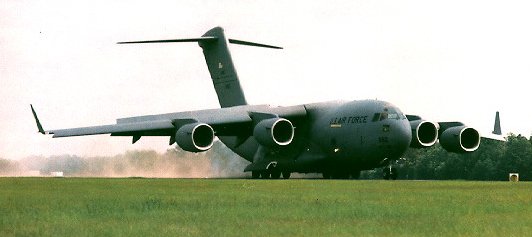|
|
| Boeing
C-17C Globemaster III |
|

|
|
The C-17 is possibly the most flexible
airlift aircraft to enter the Air Force inventory since the C-130 Hercules.
The ultimate measure of airlift effectiveness is the ability to
rapidly project and sustain an effective combat force close to a
potential battle area. The Boeing C-17 Globemaster III is capable of
rapid strategic delivery of troops and cargo to main operating
bases, or directly to forward bases in the deployment area. The
aircraft is also able to perform tactical airlift and airdrop
missions when required. The inherent flexibility and performance
characteristics of the C-17 force improves the ability of the
total airlift system to fulfill the worldwide air mobility
requirements of the United States.
Threats to U.S. interests have changed in
recent years, and the size and weight of U.S. mechanized
firepower and equipment have grown in response to the improved
capabilities of potential adversaries. This trend has
significantly increased air mobility requirements, particularly
in the area of large or heavy outsized cargo. As a result,
additional airlift is needed to meet potential armed
contingencies, peacekeeping or humanitarian missions worldwide.
The C-17 will fill the void left by the aging C-141B Starlifter,
which is currently in its retirement phase
out process.
The C-17 program was restructured in 1990
following the OSD Major Aircraft Review, reducing the planned
buy from 210 to 120 aircraft.
Since 1995, the fleet has amassed more than
250,000 flying hours. The C-17 has been involved in numerous
contingency operations, including flying troops and equipment to
Operation Joint Endeavor to support peacekeeping in Bosnia and
Allied Force Operation in Kosovo. In 1998, eight C-17s completed
the longest airdrop mission in history, flying more than 8,000
nautical miles from the United States to Central Asia, dropping
troops and equipment after more than 19 hours in the air, a feat
repeated in 2000.
|
|
